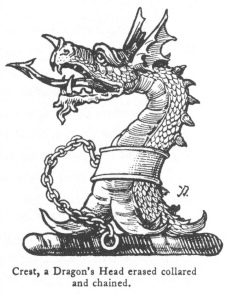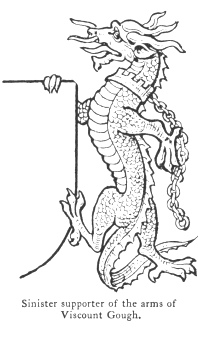
Sacred Texts Legendary Creatures Symbolism Index Previous Next
Buy this Book at Amazon.com


Fictitious and Symbolic Creatures in Art, by John Vinycomb, [1909], at sacred-texts.com
The mythical dragon is represented in heraldic art with the huge body of the reptile saurian type covered with impenetrable mail of plates and scales, a row of formidable spines extending from his head to his tail, which ends in a great and deadly sting; his enormous jaws, gaping and bristling with hideous fangs, belch forth sparks and flame; his round luminous eyes seem to shoot gleaming fire; from his nose issues a dreadful spike. He is furnished with sharp-pointed ears and a forked tongue, four sturdy legs terminating in eagle's feet strongly webbed, clawing and
clutching at his prey. Great leathern bat-like wings armed with sharp hook's points, complete his equipment. The wings are always "endorsed," that is, elevated and back to back.
The dragon of our modern books of heraldry is a miserable impostor, a degenerate representative of those "dragons of the prime, that tore each other in their slime." It is curious to note in this the gradual degradation from the magnificent saurian type of the best period of heraldic art to a form not far removed from that given to an ordinary four-legged creature covered with plates and scales. His legs are longer and weaker, his mighty caudal appendage, shrunk to insignificant and useless
 |
Arms of the City of London.—Two dragons are the supporters of the arms of the City of London, the crest a dragon's sinister wing. They are thus blazoned: Argent a cross gules, in the first quarter, a sword in pale point upwards of the last. Supporters, on either side a dragon with wings elevated and addorsed, argent, and charged on the wing with a cross gules.
The crest is a dragon's sinister wing charged with a similar cross.
The County of Chester has for its supporters two dragons, each holding an ostrich feather.
Basingstoke, Linlithgow and Dumfries on the town seals have St. Michael overthrowing the dragon (see p. 72).
The dragon appears in various forms in the arms of many towns, and also in those of some peers.
One of the most extraordinary and elaborate coats of arms of modern times is that of Viscount Gough. The sinister supporter
 |
Examples vary considerably in the form of the dragon, some early examples represent it to have four legs, others with only two, when it is properly a wyvern. The pendent "George" in the Order of the Garter represents it with a body similar to a crocodile, winged and covered with plates and scales.
A similar device to that of the George noble of Henry VIII. was the St. George slaying the dragon by Pistrucci, a foreigner employed at the mint. This handsome reverse, says Mr. Noel Humphrey, "Coin Collector's Manual," is nearly a copy from a figure in a battle-piece on an antique gem in the Orleans collection, but several Greek coins might equally well have furnished the model. Old George III. sovereigns and five-shilling pieces have
this most finely conceived and executed device on the reverse of the coins. It also appears upon some sovereigns of Queen Victoria. Prominence is naturally given to the figure of St. George, the dragon in consequence being diminished in its relative size.